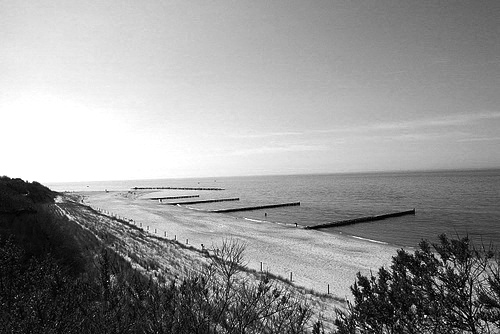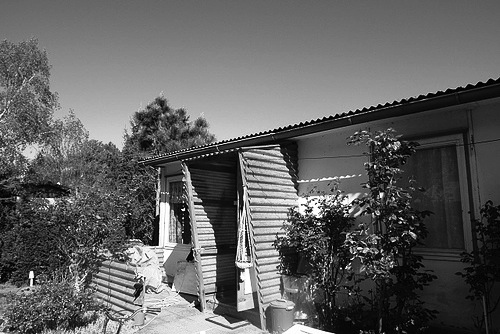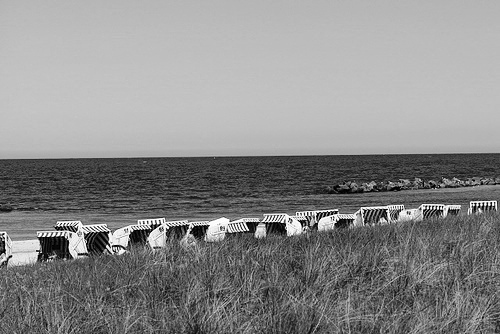Berliner Paul Scraton paints a portrait of the Baltic Coast for Caught by the River…
On the train north from Berlin the carriage is packed. At the Hauptbahnhof people clambered excitedly aboard with their belongings, their bicycles and their picnic baskets. Some are heading for the forests and lakes that begin even before the suburbs of the German capital give way to the surrounding countryside, but the majority is here for the duration and will complete a journey that has been made for generations… the escape to the seaside.
The first bathing resort on the Baltic coast was established even before the coming of the railway in the 1840s, and Heiligendamm – inspired by British seaside towns and founded in 1793 – was designed as a haunt for the aristocracy. It still sees itself, with its white palaces and luxury hotels, as a cut above and was still seen as grand enough to be chosen for the G8 summit of 2007 when the world’s largest wicker beach chair was built to allow space for Angela Merkel, George W Bush, and the rest of the motley collection of world leaders to pose with the calm waters of the Baltic as the backdrop.
Now the world leaders and the tens of thousands of protestors who follow wherever they choose to gather are nothing but a memory as the regional train pushes on through the forests, fields and lakes of the northern German flatlands. Through the window we can see small villages clustered around red brick churches, red kites circling in the sky, and wind turbines frozen in place. There are no clouds, and there is no breeze either. It is this type of weather that drives Berliners out from the sweltering city towards the sea.
A few hours later and we reach our destination, and first glimpse of the glittering sea across the fields and between the trees. The passengers disembark and then spread out – to connecting trains and buses that will take them further down the coast – through a landscape of dykes and dunes, wide sandy beaches and moody inland seas, and the chance to reflect on the fact that all those years behind the iron curtain actually served to protect this stretch of the Baltic coast. For this was once the GDR – East Germany – and our own destination, a collection of small bungalows on a strip of land between the dunes and the inland sea, looks pretty much as it did before the fall of the Berlin Wall.
Some of these cabins – weekend homes surrounded by small gardens – have been renovated, winterproofed and gussied up with wood-burning stoves and satellite dishes, but many remain unchanged from a time when they provided people with an escape from everyday life under the so-called socialism of the GDR. What all of these buildings contain are memories, of long summers and family holidays, and we have been leaving our own here with each trip north that we make from our home in Berlin.
But the Baltic is more than just a holiday destination, for this remains Germany and so the memories of the region will never be purely light and carefree. You can drive through the beautiful landscape of the island of Rügen and come across a huge holiday camp, built by the Nazis as part of the “Strength through Joy” leisure organisation. Or you can make your way to the northern tip of the island of Usedom, and stumble upon the place where the German Army developed the V1 and V2 rockets, that rained terror on London, Antwerp and other cities in Europe.
In her book Europe, Jan Morris described the Baltic as “to my mind the most ominous and eerie of Europe’s waters. Fearful things happen in the Baltic. Wars embroil it. Ice freezes it. Unidentified submarines prowl it. Empires storm this way and that across its shallows…” and as we walk along the dyke path, past the crumbling remnants of a WWII watchtower we cannot help but reflect on the contradictions of a place that combines both beauty and tranquility with the “ominous and eerie”.
We find it too on the front page of the local newspaper the next day, and a combination of stories that include a planning dispute over a fish restaurant and renovations to one of the resort piers, but also a new memorial unveiled to a family deported to the extermination camps of Poland and an upcoming Heimattreffen (homeland meeting) for the descendants of those Germans forced West in the aftermath of war, to discuss – over coffee and schnapps – those lands long lost in the east.
Down on the beach kids paddle in the shallows whilst a group of teenagers carry a crate of beer towards the watchtower, in search of shelter from both the cooling breeze and prying eyes. As we pick our way through the trees towards our bungalow so filled with memories we talk about this place, this coastline of holiday resorts and nature reserves, of beaches and ice cream stalls but also the remnants of the tragic and the terrible, the melancholic and the mundane. And we reflect on how these contrasts are what makes the Baltic such a fascinating place, and this is why we will continue to be drawn back on journeys north from the city to the sea, time and again.
See more from Paul here
Read more from Paul Scraton on Caught by the River here


